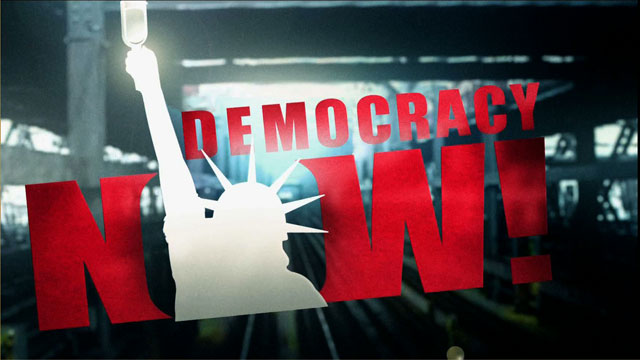
Guests
- Julia Butterfly Hillfounder, Circle of Life Foundation.
After living in an ancient redwood in Northern California for two years, environmental activist Julia “Butterfly” Hill came back to earth Saturday, her legs wobbly after her sojourn in the towering tree she called Luna. But she worked out the kinks, then hiked — on bare feet — the two miles from the tree to a news conference.
Twenty-five-year-old Hill, who has lived in the tree since Dec. 10, 1997, to protest logging, reached an agreement Friday with Pacific Lumber Co. and promised to climb down from her 18-story-high perch, which is on company property.
Pacific Lumber representatives did not attend the news conference.
In the agreement, Hill and her supporters pledged to pay $50,000 to Pacific Lumber to make up for lost logging revenue. The firm agreed to spare Hill’s redwood and a 2.9-acre buffer zone around it. The company will give the $50,000 to Humboldt State University for forestry studies.
Transcript
AMY GOODMAN: This is Democracy Now! I’m Amy Goodman.
JULIA BUTTERFLY HILL: [weeping]
AMY GOODMAN: The sound of Julia Butterfly touching earth.
JULIA BUTTERFLY HILL: I think before anyone could ever be allowed to cut down shoes like this, they should be mandated to live in it for two years.
AMY GOODMAN: Julia Butterfly, speaking just after she hit the ground, leaving her ancient redwood tree, Luna, saying that anyone who wants to cut down a tree should be forced to live in it for two years. Well, after living in the ancient redwood in Northern California for two years, environmental activist Julia Butterfly Hill did come back to earth on Saturday, her legs wobbly after her sojourn in the towering tree. But she worked out the kinks, then hiked on bare feet the two miles from the tree to a news conference.
Twenty-five-year-old Julia, who’s lived in the tree since December 10th, 1997, to protest logging, reached an agreement Friday with Pacific Lumber Company and promised to climb down from her 18-story-high perch, which is on company property. Pacific Lumber representatives did not attend the news conference. In the agreement, Hill and her supporters pledged to pay $50,000 to Pacific Lumber to make up for lost logging revenue. The firm agreed to spare Hill’s redwood and a 2.9-acre buffer zone around it. The company will give the $50,000 to Humboldt State University for forestry studies.
And today, we’re joined by Julia Butterfly in our studio here in New York.
Welcome to Democracy Now!, Julia.
JULIA BUTTERFLY HILL: Thank you, Amy. It’s good to be here and see you in person.
AMY GOODMAN: Well, that’s right. I’m used to talking to you on a cellphone high up in the tree. In fact, we last talked just last week. We also had a representative of Pacific Lumber on. Can you describe the scene of you doing that interview?
JULIA BUTTERFLY HILL: Well, that morning was — it was about 5:30 or I guess it was about 6:00 on the West Coast, and on my platform, I didn’t get good reception on my phone. And so, for interviews needing really clear reception, I actually had to get out of my warm sleeping bag and go climb out onto a branch. So, as I was talking to you last, I was perched on a branch like a bird, but I was shivering away, trying to hear what he was saying and take mental notes and speak clearly at the same time. It was quite an event.
AMY GOODMAN: Not exactly a level playing field, I should say. But you certainly have taken on the entire lumber industry in this country by your stand for the last two years. Tell us about this agreement that you’ve reached with Pacific Lumber.
JULIA BUTTERFLY HILL: Well, you know, when I first climbed into Luna, the over 1,000-year-old ancient redwood, I thought that I was going to be there three weeks to a month. I told a friend, “See you in a few.” And 738 days later, I finally climbed down.
But during that time, I felt guided that I was supposed to give my word that my feet would not touch the ground again until I’d done everything I could to make the world aware and raise consciousness and get Luna and the area protected. So, you know, every day that I was in that tree was an accomplishment of that first goal, more than I ever could have expected, but it was a long, tedious process to get Luna and the buffer zone protected.
The necessary protection for a tree like that, it needs a family, just like you and I. We need family and friends to keep us strong. So, just to protect Luna by herself would not have been enough.
Actually, in July, I had a verbal agreement, and a written document that reflected that verbal agreement, from the Pacific Lumber Maxxam Corporation, that said they would indeed protect Luna and that 2.9 acres, and that, in turn, I had to agree to a few things that I felt I could agree to, I didn’t have a problem agreeing to. And then, the very next day, they went incommunicado, and they pulled out. But Charles Hurwitz is notorious for that, the CEO of Maxxam Corporation, that owns Pacific Lumber. He did it with — when he took over Pacific Lumber, he did it with the Headwaters Forest agreement, pushing all the way to the last minute and then backing out so he could get more concessions, pushing and backing out.
But in the end, it started getting — when we spoke last, it was starting to get into mud slinging, and I didn’t want that. I speak truth. I speak love. I speak respect, to the best of my ability. And I don’t like name callings. And the company was going to that point. They were also trying to restrict my rights to free speech. They were trying to control and manipulate my values, my beliefs and my morals. And I drew a line there, and I said, “I’m willing to hear anything else you have to say, but you cannot cross that line.” So, then we came to an agreement.
AMY GOODMAN: What do you mean, free speech?
JULIA BUTTERFLY HILL: Well, they wanted me to sign a statement that would discredit civil disobedience, that would discredit tree sitting, that would discredit the forest protection movement, that would pat them on the back for their supposedly good forest stewardship practices in their HCP, which is a Habitat Conservation Plan. And my name for that acronym is a “horrible concept, period.” I’m not going to pat anybody on the back. It’s a bad idea. I don’t agree with it. So, that’s what they were trying to do, was manipulate me, basically trying to turn me into their own spokesperson. And I wasn’t about to do that.
AMY GOODMAN: And so, this agreement, what is it?
JULIA BUTTERFLY HILL: Well, the agreement is a preservation agreement, and it is a deed of covenant now held into perpetuity by the Sanctuary Forest Land Trust. And in exchange for protecting Luna and the 200-foot buffer, I did agree to the $50,000. I’d like to say that I actually asked the company to give it to their workers. We’re in the holiday season. A lot of their workers were laid off because of the destructive practices of the company, and what a great gift to give to the workers for holidays. And the company refused. So I think it’s interesting that spokespeople like Josh Reiss from Maxxam say, “Oh, it’s all about our workers,” yet they refuse to give the money to their workers.
I also agreed that I would not climb back up or trespass, climb up into any of their trees or trespass, and — but I’m allowed to go back and visit with 48 hours’ notice. And that’s about the basic extent of the agreement.
AMY GOODMAN: Will you be visiting Luna?
JULIA BUTTERFLY HILL: Absolutely, absolutely. When I first — when I was sitting there at the top of the tree getting ready to rappel for the first time in two years, I began to cry, because it was so many emotions going through me, and — but Luna reminded me that all I had to do is touch my heart, and that’s where she truly resides. And no matter where I am, including in the studios now, that if I touch my heart, Luna’s there, and I can be with her in that way, as well.
AMY GOODMAN: We can talk about your two-year sojourn, but this period of less than a week where you’ve been out of the tree has been anything but a sojourn, which I think of as a more quiet term. Can you describe what has happened since Saturday?
JULIA BUTTERFLY HILL: Well, part of the agreement I had with the Pacific Lumber Company was that I would have seven days to sit up there and be with Luna, take the sit down, have that chance to figure out what I’m going to do next and have that time to say goodbye to a living being that I had spent the last two years of my life with. But it got leaked to the press, so I had one day. So, basically, I spent that one day gathering my belongings that I felt I might need. I rappelled down. After my moments of emotion and sitting there at the base of the tree and speaking with the people there, I hopped right up. I was handed a walking stick. And I think I floated down that mountain. I don’t remember my feet touching the ground. It was incredible.
But I hiked straight into a press conference, did the press conference, and — because I wanted people to see me as a woman who had just lived in a tree for two years. I didn’t want to go and just appear all fresh. I wanted people to see: This is what a woman looks like when she comes out of a tree for two years. And then it’s just been one thing another. I jumped into a car for the first time. I had one night to plan or try and plan what we were going to do. I had to borrow friends’ clothing, because all I had was stuff to live in a tree. I drove to San Francisco, hopped on a plane, came to New York, and it’s been a whirlwind ever since.
AMY GOODMAN: How many national TV shows have you done?
JULIA BUTTERFLY HILL: On my first day, I did six. And that was just the first day.
AMY GOODMAN: I saw you on The Today Show, NBC.
JULIA BUTTERFLY HILL: That was the first one I did. And it was really hard, because that little clip that you played of me first touching the ground, it’s still very intense for me. I feel that moment every time I hear it, and it’s very hard for me not to break down. So, on The Today Show, I’m sitting in a room surrounded by cameras, bombarding me with this scene, and trying to keep my composure. It’s been — everything’s a learning lesson, and this is no exception.
AMY GOODMAN: I couldn’t help but think, when I saw those images of you and the fact that you’ve lived in this tree for two years, what it takes for a person who takes on some of the largest and most powerful corporations to get a microphone open to them, as opposed to the people who get their calls in their corporate suites to come on television all the time. But you have had, to say the least, a powerful effect on the entire environmental movement. Now, what are the questions that the corporate media is asking you? And are they willing to talk about Maxxam and Pacific Lumber?
JULIA BUTTERFLY HILL: Well, some of the corporate media is willing to talk about the issues, but, you know, it’s — the greatest thing in the coming down, of course, other than saving this symbol of hope, this over 1,000-year-old redwood, every good thing that came out of it — having the chance to speak live with mainstream press, they can’t edit out the truth. They can’t edit out the hard-hitting aspects of this issue. So that’s been really wonderful. They asked some of the usual fluff questions. But one of the things I’ve learned in the last two years of doing media is, is no matter what they ask me, learning how to point it back to the issues that I care about.
AMY GOODMAN: We’re talking to Julia Butterfly, and, yes, she’s come down from her perch, from — how tall was the tree?
JULIA BUTTERFLY HILL: Two hundred feet tall, nearly 15 feet in diameter at the base.
AMY GOODMAN: And how old?
JULIA BUTTERFLY HILL: Estimated over a thousand years.
AMY GOODMAN: Over a thousand years, come down just within the last week, after two years of living in that tree. We often talked to you in the tree for a brief period of time, and you described the physical surroundings. But place Luna in Northern California, for listeners who are listening in Hawaii and Maine and Florida, New York.
JULIA BUTTERFLY HILL: Well, Luna sits on a beautiful ridgetop above the little town of Stafford, California, in northern Humboldt, Northern California. It’s probably about 45 miles — well, maybe a little more, but somewhere near around 45 miles south of the ocean. The town of Stafford is the little town below, had seven families’ homes destroyed by a mudslide caused by the destructive logging practices of Pacific Lumber Maxxam Corporation. So, around Luna is this beautiful grove, but right next to Luna is this massive gash in the earth, where the mountain just slid away and destroyed the homes. I can see — when I was there, there were mudslides and clear cuts everywhere. And so, I think that one of the most effective things for me in the last two years was that industry and a lot of corporate media want to throw scientists and professors at us and politicians at us, but there’s nothing that can compare to real experience and what we see with our own eyes. That’s a truth that they can’t sign away.
AMY GOODMAN: And what portion of the land there is owned by Pacific Lumber?
JULIA BUTTERFLY HILL: Pacific Lumber Maxxam Corporation owns 200,000 acres of land. The Headwaters Forest agreement only permanently protected 3,500 acres of old-growth and ancient and 3,500 acres of cut over and clear cut. So there’s still a lot of work to be done. And that’s really important for me to try and get that out there, that I don’t want people to think, “Well, Julia Butterfly Hill came down. The forest is saved. We can go back to our little lives.” Not only the ancient redwoods, but our old-growth forests across the country and around the world, and our forests in general, need our help, because we’ve got industry looking to consume as fast as possible, and consumers who are not aware that they’re part of that process. So we have work to do.
AMY GOODMAN: Julia Butterfly, we have to break for stations to identify themselves. And I know you’re off to more interviews, but I do want to ask you to stay just for a few more minutes to ask where you personally go from here. You’re listening to Pacifica Radio’s Democracy Now! After we speak with Julia Butterfly, we’re going to talk about a landmark decision reached Monday by the Vermont Supreme Court, ruling in favor of three same-sex couples who challenged the constitutionality of Vermont’s marriage laws. And then we’re going to be talking about reporters at a major news outlet who have taken on their own management and done an investigation. We’ll report on the results. You’re listening to Pacific Radio’s Democracy Now! We’ll be back in a minute.
[break]
AMY GOODMAN: You are listening to Pacifica Radio’s Democracy Now!_, The Exception to the Rulers. I’m Amy Goodman, joined by Julia Butterfly Hill. She is in our studio. We’re not talking to her on a cellphone atop Luna, a 200-foothigh, 1,000-year-old ancient redwood, where she has lived for the past two years, just coming down last Saturday, just coming down in this last week of the century, this last week of the millennium. Did that have an impact on your decision to come down now?
JULIA BUTTERFLY HILL: Well, it didn’t have an impact. You know, I was — as incredible as it was living in that tree, I was ready to come down many times. It was not an easy experience. But I just felt in my heart that we had to protect this tree. You know, 97% of the original ancient redwoods are gone. So, we’re talking about each and every one of the trees is vital, absolutely vital. And then, we also — I felt that because of the mudslide, that the hillside, whatever we could protect of that hillside was vital in holding it up.
But I think it’s interesting to note that this tree has been standing since the beginning of the millennium, and now it can stand for another millennium. And I think that’s wonderful. That, to me, is one of the greatest things that came from this action, is the symbol of hope that the action and the tree became to the world, that we, as individuals, do have impact, that we are responsible for our choices, and that our choices shape the world. But with enough love and commitment and joining together in action, there’s nothing that we can’t accomplish.
AMY GOODMAN: Julia Butterfly, what was the hardest part of being up in that tree for two years?
JULIA BUTTERFLY HILL: Oh, I think I could talk for a day or two about all the difficulties. I think the first three months were the hardest for me. After the first three months, I was broken on every level, physically, emotionally, spiritually, mentally. I have never been under an onslaught that difficult in my life. But what it did was, by breaking me, it broke me free of my attachments to my perceptions of myself, my attachments to how strong I thought I was, and it allowed for me to realize that no matter how difficult things are, that it’s the struggle and adversities that make us beautiful. It is the struggles and adversities that allow us to be free, because people say a lot, “How do you stay so optimistic?” And I always tell people, “Well, when you’ve been to hell and made it back out alive as many times as I have, there’s no choice but optimism.”
AMY GOODMAN: Your father was waiting for you at the bottom of the tree.
JULIA BUTTERFLY HILL: Yes.
AMY GOODMAN: How was your family through this period?
JULIA BUTTERFLY HILL: I had incredible support from my family. They were very concerned about my safety, as a lot of people were, but they believed in me. They believe in the fact that there’s a difference between greed and need. And we’re in a part of our society right now where destroying the last of our ancient redwoods, dumping diesel fuel and herbicides, destroying fishery habitat, all of the things that are happening is happening only because of greed. And we, as individuals, can and must begin to take action to change that.
AMY GOODMAN: How many — how many redwoods are left in the world today?
JULIA BUTTERFLY HILL: Well, the particular coastal redwoods only exist in California, there in Northern California. They are part of the coastal temperate rainforest. But 97% of that is gone. So, I don’t know the exact, like, number of the trees, but a little teeny portion was protected in the Headwaters Forest agreement. There are a few isolated groves protected now under federal and state lands. But what we’re talking about is that we’ve got to protect what’s left and create these buffer zones, because these forests can’t live isolated. They need a way of protection.
AMY GOODMAN: How many are gone?
JULIA BUTTERFLY HILL: Ninety-seven percent of the original ancient redwoods are gone.
AMY GOODMAN: And why are redwoods so important?
JULIA BUTTERFLY HILL: Well, I think it’s — number one, like, to the average person out there, it’s like a part of our national heritage. It’s something ingrained in a lot of people in this country that it’s a part of who we are. But more than that, our ancient and old-growth forest holds secrets from a millennium. How can we think that we can cut them all down and not lose an intrinsic part of ourself and all of the species that rely on these forests to survive, including ourselves?
AMY GOODMAN: And can you tell our listeners what Maxxam is, that took over Pacific Lumber? And did it matter that it took it over? Did it make things worse?
JULIA BUTTERFLY HILL: Absolutely. Pacific Lumber, before Maxxam Corporation, was operated as a mostly family-run and -operated business and community business. And Maxxam is a corporation based in Houston, Texas. And, of course, corporations are structured that they have to make a profit for their shareholders, so all of those people want to see revenue off of the trees and off of the workers, even though their lives aren’t invested in that area. So, the rate of cut doubled and, in some cases, tripled. They reinstated clear cutting and the subsequent use of diesel fuel and herbicide. Maxxam Corporation now dumps 40 gallons of diesel fuel per acre under their clear cuts to carry the herbicide. Not only are they destroying the forest, they’re poisoning the land, the animals, the water and the people.
And my hope is that the coming to this agreement is proof that we can work together. We have a long way to go, but if we, the people, join together and stand up against the corporate structure and say, “The air that we breathe, the water that we drink, this planet that keeps us alive, our love for life has got to rise above our love for money,” and if we stay committed to that, we can make it happen.
AMY GOODMAN: Have you ever spoken to Charles Hurwitz?
JULIA BUTTERFLY HILL: Charles Hurwitz refuses to speak to me, although I sent him many letters over time. They always return my calls back to Pacific Lumber, but I did speak with John Campbell, president of Pacific Lumber. I spoke to the spokespeople for both companies many times. But Charles Hurwitz, so far, has not decided to speak to me, although I’ll keep trying.
AMY GOODMAN: Where are you headed now?
JULIA BUTTERFLY HILL: Oh, out the door, onto the street into another whirlwind.
AMY GOODMAN: Your life, as you see it — you’re 25 years old. When you finish with this whirlwind, where do you go?
JULIA BUTTERFLY HILL: My hope is that what I — one of the greatest things, I feel, that I’ve been able to accomplish with the last two years is showing that we, as individuals, can make a difference, and that we can — no matter how different people seem, there is common ground if we work hard enough for it. And so, I hope to bring that message in person to people. I think while I was in the tree, some people didn’t see me as a real human being, which disempowered them. But I want to empower them. I’m not a superhero. I’m just a woman with a lot of love. And I want to empower that in others to get actively involved in making our world a better place.
AMY GOODMAN: If people want to get in touch with your group, where can they call?
JULIA BUTTERFLY HILL: They can call area code 707-923-9522, and that’s the Circle of Life Foundation. And for people who are computer savvy, of which I’m not one, the website is very simple, www.LunaTree.org.
AMY GOODMAN: That’s www.LunaTree.org. And what is the Circle of Life Foundation?
JULIA BUTTERFLY HILL: The Circle of Life Foundation is something that I established to try and help, basically, continue what I’ve done in the tree for the last two years, but now magnify and build upon it, because I’m down on the ground, which is networking, bringing all the incredible people that are on this planet doing amazing things, bringing them together, empowering each other and empowering the average American, the average person in our world, to get involved in creating a more sustainable culture that’s rooted first in our love and respect for all life. And that’s the way we’re really going to protect this Earth. That’s the way we’re going to protect each other. And for the person who’s only focused on jobs, that’s the way we’re going to protect the jobs, too.
AMY GOODMAN: Will you remain Julia Butterfly?
JULIA BUTTERFLY HILL: Absolutely. Butterfly — actually, a butterfly landed on my finger when I was 7 years old, when I was hiking in the mountains, and stayed with me for hours. And so, butterfly has been a part of my entire life, and I’m sure will continue to be a part of my life as I continue metamorphosing in this new world in which I’ve reentered.
AMY GOODMAN: Well, welcome back.
JULIA BUTTERFLY HILL: Thank you so much. It’s great to be here.
AMY GOODMAN: Julia Butterfly Hill. You are listening to Pacifica Radio’s Democracy Now!
JULIA BUTTERFLY HILL: I think before anyone could ever be allowed to cut down shoes like this, they should be mandated to live in it for two years.
[break]
AMY GOODMAN: You are listening to Pacifica Radio’s Democracy Now! By the way, Julia Butterfly’s book, The Legacy of Luna, will be coming out the first week of April, and she’ll be donating 100% of the profits to environmental causes.

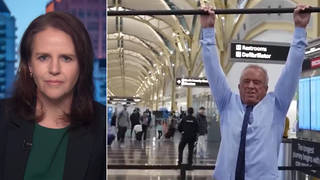



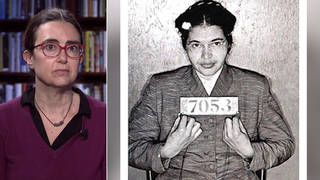
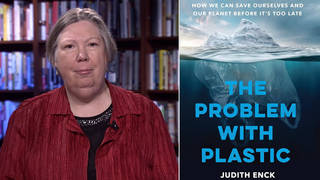
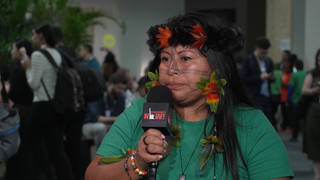
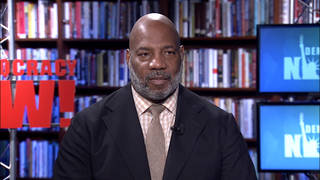
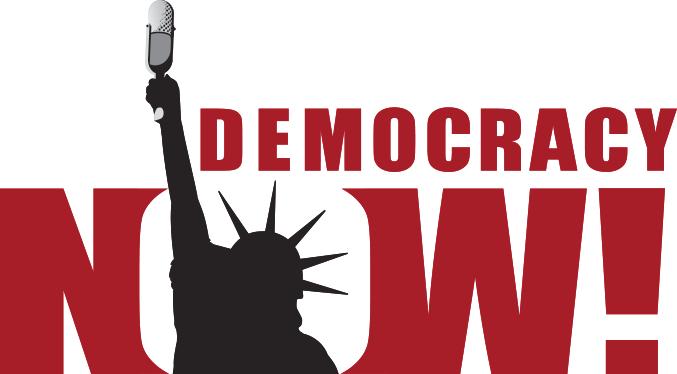
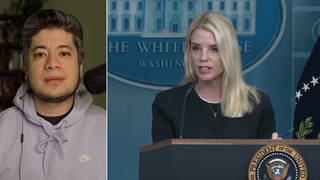
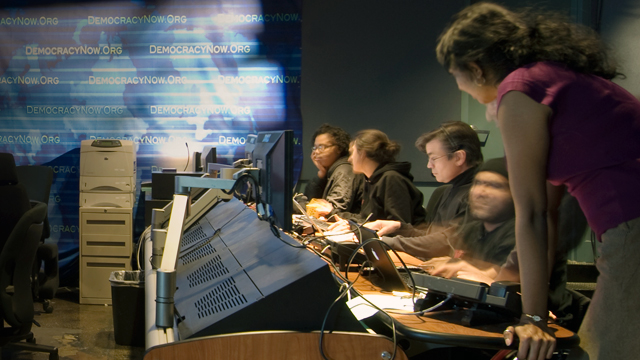

Media Options